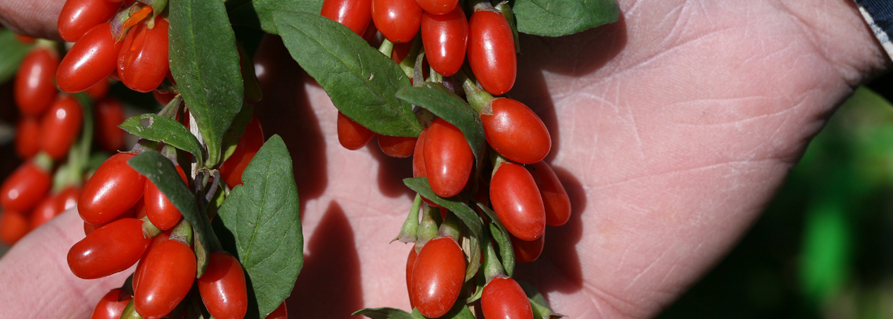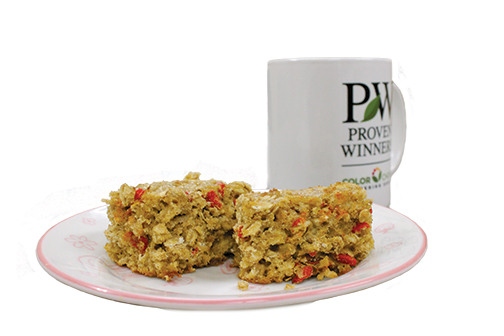All About Lifeberry® Goji berries (Lycium Barbarum)
Goji is a sprawling shrub with long, flexible canes and clusters of small, grey-green leaves. The flowers are a brilliant royal purple and they appear in late spring/early summer along the length of the canes. They give way to juicy, bright red fruits that resemble small peppers. They grow sweeter as they mature on the plant. Goji plants continue to flower and produce fruit through the first heavy frost.

Though they sound exotic and are most often found with a high price tag in health food stores, Goji berries are actually easy to grow hardy plants. If they weren’t, well, we wouldn’t have added them to the line of Proven Winners® ColorChoice flowering shrubs. We’ve got two varieties of tasty, beautiful goji berries: Sweet Lifeberry® and Big Lifeberry®. These exceptional strains were specially selected in China, where goji has been grown for centuries for its purported health-giving properties and brilliant fruit color (red symbolizes joy in Chinese culture). Sweet Lifeberry and Big Lifeberry goji have been a hit in Europe and we are pleased to finally offer them to North American gardeners.
Description: Goji is a sprawling shrub with long, flexible canes and clusters of small, grey-green leaves. The flowers are a brilliant royal purple and they appear in late spring/early summer along the length of the canes. They give way to juicy, bright red fruits that resemble small peppers. They grow sweeter as they mature on the plant. Goji plants continue to flower and produce fruit through the first heavy frost.
How to grow
Zone: hardy to USDA zone 5; heat tolerant to AHS zone 9
Exposure: Full sun is best, but tolerates a bit of shade.
Height: 5-7’ (1.5-2.1 m)
Water: The plants tolerate some drought once established, but for best fruit set and quality, water regularly.
Soil: Any well-drained soil will do.
Staking: Goji naturally wants to sprawl and creep along the ground. To save space and to make harvesting the berries easier, you can bundle the strongest 3-5 canes around a 6-8’/1.8-2.4m tall stake (choose something sturdy, like 1”x1” wood).
Pests: Goji berry plants will not be bothered by insects or diseases, but birds, deer, and raccoons may all find the fruit as appealing as you do. If you notice damage to the fruit or plant, or have a problem with these visitors damaging other plants in your garden, use a netting or repellent, particularly once the plant begins flowering and fruiting.
Pruning: Goji does not require pruning to grow well and produce fruit. However, you may find the plant is more manageable and easier to harvest when its lateral (horizontal) branches are lightly pruned to encourage branching and the production of vigorous new growth.
Harvesting: Goji berries begin to ripen in early summer. They should be plucked off by hand when they are brilliant red and taste sweet. They come off the plant easily, without the need for pruners or a knife.
Fertilizing: For an abundant crop, apply a fertilizer formulated for flowering woody plants in early spring, just as new growth begins. Rose fertilizer is an excellent, readily available choice.
FAQ
Can I grow goji berry in a container?
Yes! Goji will do great in a container. Just be sure to choose one large enough – it should be at least 18” in diameter and have a drainage hole. The container should also be weatherproof so that it can remain outside, planted with your goji, all year long. Use any regular potting soil to plant in and be sure to keep a close eye on watering, particularly during the hottest part of the summer.
When are my goji berries ready to harvest?
Goji berries turn red very quickly but will taste slightly bitter until they are fully ripe. Taste is your best indicator, but in general, the berries should spend several weeks on the vine before being harvested. It is best to harvest before the first frost, however, because cold can diminish the flavor of the fruit.
Where can I grow goji berries?
Goji berries will thrive in the majority of the US and Canada. They are hardy to USDA zone 5, with maximum low temperature around -18 degrees F/-27 degrees C; if you live in a colder climate and would like to try goji, you will get berries that summer but the plant may not come back next year. Goji is very tolerant of hot and dry climates –in fact, many of its relatives grow wild in the deserts of Arizona, Texas, and Mexico.
Do I need two gojis for pollination?
No – gojis are self-fruitful. They do not require another plant to bear fruit.
How do I use my goji berries?
You can use your goji berries in the same way that you use those that you purchase in the store. They can be used fresh if you wish, or they can be frozen or dried. To dry gojis, harvest them and simply spread the fresh berries in a single layer on a sheet of newspaper. Keep in a cool, dry spot, out of bright light, until the berries are dry. They keep their color well and can be used as is or rehydrated with liquid, as your recipe and preferences dictate. To freeze, place in a freezer bag and lay flat until frozen. This keeps them from sticking together in large clumps. Well-sealed frozen goji berries should keep for several months and can be used straight from the freezer in your recipe.
Here are two of our favorite recipes for using your goji harvest:
|
|
Uncle Buck’s Goji Salsa
Bring all ingredients (except tomato paste) to boil. Simmer 45 minutes. After 30 minutes, stir in tomato paste. Yields 8 quarts. |
|
|
Sweet Lifeberry® Breakfast Bars
|
Preheat oven to 350°F. In large bowl combine sugars, yogurt, egg whites, oil, milk and vanilla; mix well. In medium bowl combine flour, baking soda, cinnamon and salt; mix well. Add dry ingredients to wet mix; mix well. Stir in oats and goji berries. Spread dough onto bottom of ungreased 13 x 9 baking pan. Bake 28-32 minutes or until golden brown. Cool completely on wire rack. Cut into bars. Store tightly covered.
Do I need to do anything to my gojis for winter?
If you live in zone 5 or warmer, you’ve got nothing to worry about! A 2-3” thick layer of shredded bark mulch over the entire root zone of the plant is a welcome blanket to insulate against fluctuating temperatures and conserve moisture. Other than that, however, goji require no special treatment for the winter.
Do I need to prune my goji berries every year?
Your goji will grow and thrive, even if you never prune it once. However, it will be easier to harvest with some selective pruning. Simply shorten the horizontal branches by about half to two-thirds in early spring, just as the buds begin to break. Plants can withstand severe pruning, but fruiting may be minimal in the following season.
Got more goji questions? We’re here to help! Contact us anytime.






